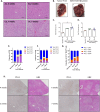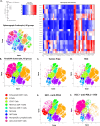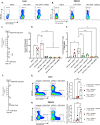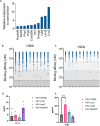Expression of tumor antigens within an oncolytic virus enhances the anti-tumor T cell response
- PMID: 38937436
- PMCID: PMC11211353
- DOI: 10.1038/s41467-024-49286-x
Expression of tumor antigens within an oncolytic virus enhances the anti-tumor T cell response
Abstract
Although patients benefit from immune checkpoint inhibition (ICI) therapy in a broad variety of tumors, resistance may arise from immune suppressive tumor microenvironments (TME), which is particularly true of hepatocellular carcinoma (HCC). Since oncolytic viruses (OV) can generate a highly immune-infiltrated, inflammatory TME, OVs could potentially restore ICI responsiveness via recruitment, priming, and activation of anti-tumor T cells. Here we find that on the contrary, an oncolytic vesicular stomatitis virus, expressing interferon-ß (VSV-IFNß), antagonizes the effect of anti-PD-L1 therapy in a partially anti-PD-L1-responsive model of HCC. Cytometry by Time of Flight shows that VSV-IFNß expands dominant anti-viral effector CD8 T cells with concomitant relative disappearance of anti-tumor T cell populations, which are the target of anti-PD-L1. However, by expressing a range of HCC tumor antigens within VSV, combination OV and anti-PD-L1 therapeutic benefit could be restored. Our data provide a cautionary message for the use of highly immunogenic viruses as tumor-specific immune-therapeutics by showing that dominant anti-viral T cell responses can inhibit sub-dominant anti-tumor T cell responses. However, through encoding tumor antigens within the virus, oncolytic virotherapy can generate anti-tumor T cell populations upon which immune checkpoint blockade can effectively work.
© 2024. The Author(s).
Conflict of interest statement
The authors declare no competing interests.
Figures







Update of
-
Chimerization of the Anti-Viral CD8+ T Cell Response with A Broad Anti-Tumor T Cell Response Reverses Inhibition of Checkpoint Blockade Therapy by Oncolytic Virotherapy.Res Sq [Preprint]. 2023 Nov 20:rs.3.rs-3576281. doi: 10.21203/rs.3.rs-3576281/v1. Res Sq. 2023. Update in: Nat Commun. 2024 Jun 27;15(1):5442. doi: 10.1038/s41467-024-49286-x. PMID: 38045348 Free PMC article. Updated. Preprint.
References
-
- Global Burden of Disease Liver Cancer Collaboration, et al. The burden of primary liver cancer and underlying etiologies from 1990 to 2015 at the global, regional, and national level: results from the global burden of disease study 2015. JAMA Oncol. 2017;3:1683–1691. doi: 10.1001/jamaoncol.2017.3055. - DOI - PMC - PubMed
MeSH terms
Substances
Grants and funding
LinkOut - more resources
Full Text Sources
Medical
Research Materials

